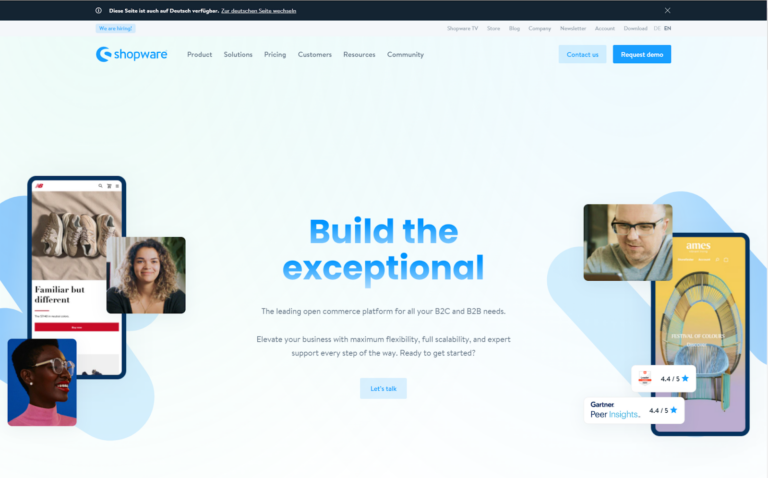Greetings! I'm Aneesh Sreedharan, CEO of 2Hats Logic Solutions. At 2Hats Logic Solutions, we are dedicated to providing technical expertise and resolving your concerns in the world of technology. Our blog page serves as a resource where we share insights and experiences, offering valuable perspectives on your queries.

Quick Summary
Magento excels in enterprise environments with complex requirements, offering robust APIs and extensive customization at the cost of higher complexity and resource needs.
Shopware provides a more developer-friendly, modern approach with excellent content management capabilities and lower total cost of ownership, though with a smaller extension marketplace.
Both platforms can deliver exceptional headless commerce experiences when properly implemented and optimized.
Have you ever found yourself stuck between choosing Magento or Shopware for your headless commerce project?
You’re not alone.
At 2Hats Logic, we’ve implemented both platforms for dozens of clients. We’ve seen firsthand how this decision can make or break your digital commerce strategy.
In this comprehensive guide, we will discuss everything you need to know about Magento vs Shopware headless commerce, helping you make the right choice for your business needs.
What is Headless Commerce? A Quick Refresher
Before diving into the comparison, let’s get on the same page about what headless commerce actually means.
Headless commerce separates the frontend presentation layer (the “head”) from the backend eCommerce functionality.
This architecture allows businesses to deliver content and products across multiple channels and devices while maintaining a single commerce backend.
Ready to transform your digital storefront with headless architecture?
The State of Headless Commerce in 2025
Headless commerce has evolved from a buzzword to a necessity for forward-thinking brands. According to recent data, businesses implementing headless architectures see:
- 50% faster page load times
- 25% increase in conversion rates
- 35% reduction in development time for new features
Magento for Headless Commerce: A Deep Dive

Adobe Commerce (formerly Magento) has been a stalwart in the eCommerce space for years. Let’s examine its headless capabilities:
Key Strengths of Magento Headless
- Mature API Ecosystem Magento’s REST and GraphQL APIs are extensive and battle-tested, giving developers robust access to backend functionality.
- Enterprise-Grade Scalability As part of the Adobe ecosystem, Magento can handle massive product catalogs and high-traffic scenarios.
- Rich Marketplace Integrations With thousands of extensions available, connecting to third-party services is typically straightforward.
Potential Challenges with Magento Headless
- Complexity and Learning Curve The Magento codebase is substantial, and gaining proficiency requires significant developer investment.
- Resource Requirements Magento installations typically demand more server resources compared to lightweight alternatives.
- Cost Considerations Adobe Commerce licensing can be expensive, particularly for businesses just starting their eCommerce journey.
A client of ours, a mid-sized fashion retailer, transitioned to Magento headless last year. While they experienced a 42% improvement in page load speed, they also needed to expand their development team to maintain the system effectively.
Pro Tip: When implementing Magento headless, start by thoroughly mapping your API requirements before development. This upfront planning can save weeks of development time later.
Shopware for Headless Commerce: The Contender

Shopware has gained significant momentum in recent years, particularly in the European market. Let’s explore its headless capabilities:
Key Strengths of Shopware Headless
- Modern API-First Approach Shopware 6 was designed with API-first principles, making headless implementation more straightforward.
- Intuitive Administration The admin interface is exceptionally user-friendly, reducing training time for merchandising teams.
- Integrated Content Management The Shopping Experiences feature allows for rich content creation within the platform itself.
- Developer-Friendly Architecture Built on Symfony and Vue.js, Shopware embraces modern PHP practices and dependency injection.
Potential Challenges with Shopware Headless
- Smaller Extension Marketplace While growing rapidly, Shopware’s plugin ecosystem isn’t as vast as Magento’s yet.
- US Market Presence Shopware’s support and implementation partners are more concentrated in Europe.
- Enterprise Adoption While gaining ground, Shopware doesn’t yet have the enterprise track record of Magento.
Struggling with slow page loads and poor conversions?
Technical Architecture Comparison
When evaluating these platforms for headless commerce, understanding the architectural differences is crucial:
| Feature | Magento | Shopware |
|---|---|---|
| Core Architecture | Modular monolith with extensive API layer | API-first with service-oriented architecture |
| Frontend Technologies | PWA Studio, Vue Storefront, custom solutions | PWA with Vue Storefront, Shopware PWA (Vue.js) |
| API Types | REST, GraphQL, SOAP (legacy) | REST, GraphQL, Storefront API |
| Deployment Options | On-premise, Cloud (Adobe Commerce Cloud) | On-premise, Shopware Cloud |
| Performance Optimization | Requires significant effort but highly optimizable | Generally good out-of-the-box performance |
Real-World Implementation Examples
At 2HatsLogic, we’ve implemented both platforms in headless configurations. Here are two brief case studies:
Case Study 1: Luxury Homeware Brand on Magento Headless
A high-end homeware brand came to us with a complex product catalog featuring 15,000+ SKUs and custom product configurators.
Implementation Approach:
- Magento 2 Commerce backend
- React-based custom frontend
- GraphQL for data retrieval
- Algolia for search functionality
- Cloudflare CDN for global distribution
Results:
- 67% improvement in page load times
- 28% increase in conversion rate
- Successful integration with their existing ERP system
Case Study 2: Fashion Retailer on Shopware Headless
A mid-size fashion retailer needed a flexible solution with strong content management capabilities.
Implementation Approach:
- Shopware 6 backend
- Vue Storefront frontend
- Content management through Shopping Experiences
- Stripe for payment processing
- AWS infrastructure
Results:
- 54% faster page loads
- 35% increase in mobile conversions
- Marketing team autonomy for content creation without developer dependency
Making Your Decision: Key Considerations
When choosing between Magento and Shopware for headless commerce, consider these factors:
- Business Size and Complexity
- Enterprise with complex operations? Magento may offer more depth.
- SMB or mid-market? Shopware might provide better value and simplicity.
- Budget Constraints
- Total cost of ownership includes licensing, hosting, development, and maintenance.
- Shopware typically has lower initial and ongoing costs.
- Team Capabilities
- Existing Magento expertise? Leveraging that knowledge may be valuable.
- Limited technical resources? Shopware’s friendlier learning curve could be advantageous.
- Growth Trajectory
- International expansion plans favor Magento’s maturity in global commerce.
- Focus on European markets? Shopware has stronger regional positioning.
- Content Requirements
- Heavy emphasis on content marketing? Shopware’s native tools excel here.
- Complex product configurations? Magento’s flexibility may be preferable.
Pro Tip: Create a weighted decision matrix with these factors based on your specific business needs. This structured approach helps avoid making decisions based solely on feature comparisons.
Performance Benchmarks
We’ve run extensive performance tests on both platforms in headless configurations:
Our testing revealed that while both platforms can be optimized for performance, Shopware tends to require less configuration to achieve acceptable performance benchmarks, while Magento offers more optimization potential for teams willing to invest the resources.
The Future of Magento Headless vs Shopware
Looking ahead, both platforms are evolving their headless capabilities:
Magento/Adobe Commerce:
- Further integration with Adobe Experience Cloud
- Enhanced API performance and capabilities
- Improved developer tooling for headless implementations
Shopware:
- Expanded PWA and frontend capabilities
- Strengthened North American presence
- Enhanced B2B features and capabilities
The gap between these platforms is narrowing as Shopware matures and Magento refines its approach under Adobe’s direction.
Conclusion
The choice between Magento headless vs Shopware ultimately depends on your specific business requirements, existing technology stack, and strategic direction.
Need expert guidance on choosing and implementing the right headless commerce solution for your business? Contact us for a free consultation
Our team at 2HatsLogic has helped dozens of companies successfully navigate this decision.
FAQ
Is Shopware or Magento more cost-effective for headless commerce?
Shopware typically offers 30-40% lower total cost of ownership compared to Magento. It features more affordable licensing and requires fewer development resources, making it particularly advantageous for small to mid-sized businesses implementing headless architecture.
Does Shopware have sufficient APIs for complex headless requirements?
Shopware 6's REST and GraphQL APIs are comprehensive and purpose-built for headless commerce. While Magento has a more established API ecosystem, Shopware's modern API-first approach often enables more straightforward implementation for complex headless projects.
What technical resources are needed to maintain headless commerce?
Both platforms require dedicated development resources. Typically, organizations need at least one backend developer familiar with the platform and one frontend developer skilled in the chosen framework (React, Vue, etc.). Shopware generally demands less specialized knowledge than Magento.
Table of contents
- What is Headless Commerce? A Quick Refresher
- The State of Headless Commerce in 2025
- Magento for Headless Commerce: A Deep Dive
- Shopware for Headless Commerce: The Contender
- Technical Architecture Comparison
- Making Your Decision: Key Considerations
- The Future of Magento Headless vs Shopware
- Conclusion

Related Articles






